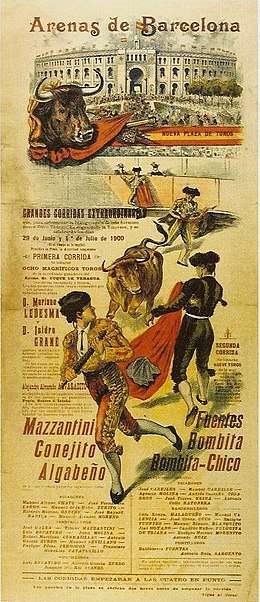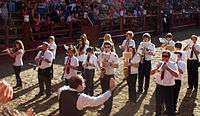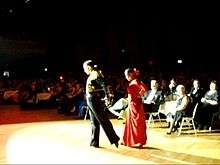Pasodoble



Pasodoble (Spanish: double step) is a Spanish military march, and also a modern dance that emulates the movements of a bullfight.
Essentially, the Pasadoble dance involves role-playing. This two-person dance form has the man performing as the bullfighter and the woman as the cape. It is known as one of the fastest Latin ballroom dances because dancers make around 120 to 130 beats/steps per minute. In some versions, the man portrays the matador in the dance, and the woman portrays the bull. Flamenco-like qualities infuse the dance as the man and woman challenge each other.
Pasodoble is a lively style of dance to the duple meter march-like music. Its original form as a Spanish military march is still interpreted in the context of the Moors and Christians festivals, in southeastern Spain, and is the major focus of current Pasodoble productions.
History
The Pasodoble came from a French military march with the name "Paso Redoble". It has both Spanish and French characteristics. The steps often contain French terms, but the dance resembles the nature of the bullfight. It is believed to have emerged from southern French culture during the 1930s. The Pasodoble was a way for the French to portray the techniques used in Spanish bullfights. The name means Two-Steps and this is attributed to the marching nature of the dance.
With a binary rhythm and moderated movement, the Pasodoble was likely based on typical Spanish dances of the 16th century. During the 18th century, it was incorporated into comedies and adopted as a regulatory step for the Spanish infantry, with a special feature that makes the troops take the regular step: 120 steps per minute. The music was introduced to bullfights in the 19th century.
Famous bullfighters have been honored with Pasodoble tunes named for them. Other tunes have been inspired by patriotic motifs or local characters. The Pasodoble is well-known and used today for dance competitions.
During the early 20th century, the pasodoble became part of the repertoire of Italian American musicians in San Francisco playing in the ballo liscio style.[1] Four pasodobles were collected by Sidney Robertson Cowell for the WPA California Folk Music Project in 1939 by Mexican American wedding party band on mandolin, guitar, and violin.[2]
Famous Spanish Pasodobles
- Amparito Roca
- El Beso
- La Entrada
- El gato montés ("Wild Cat") from the opera with the same name
- El Relicario
- Agüero
- España cañí ("Gypsy Spain")
- Islas Canarias named after Canary Islands.
- La Gracia de Dios[3]
- Feria de Manizales (unofficial hymn of the Colombian City, Manizales)
- Manolete, named after Manolete.
- La Morena de mi Copla
- Plaza de las Ventas
- Paquito el Chocolatero. The tune has a dance of its own.
- Sombreros y Mantilles
- Suspiros de España
- Que Viva España
- Valencia
- La Virgen de la Macarena
- Pasodoble hace salir el sol (The Pasodoble makes the sun come up)
Mexican Pasodobles
El Piti, El Charro Cárdenas, El 11-81, San Antonio de Triana, Fermincito, Lorenzo Garza, El abuelito, El banderillero, María Caballé, El Berrendito de San Juan, Tarde de toros, Por tapatías, Toros en San Miguel, Rodolfo Gaona, Joselito Huerta, Toros de Llaguno, La Macarenita.
By Agustín Lara: Silverio Pérez, El Novillero, Fermín.
Dance
The Pasodoble is a fast-paced Latin American dance.
Traditional

Pasodoble is based on music played at bullfights during the bullfighters' entrance (paseo), or during the passes (faena) just before the kill. The leader of this dance plays the part of the matador. The follower generally plays the part of the matador's cape, but can also represent the shadow of the matador, as well as the flamenco dancer in some figures. The follower never represents the bull, although this is a common misconception.
Ballroom
Many Pasodoble songs are variations of España Cañi. The song has breaks or "highlights" in fixed positions in the song (two highlights at syllabus levels, three highlights and a longer song at Open levels). Highlights emphasize music and are more powerful than other parts of the music. Usually, dancers strike a dramatic pose and then hold position until the end of the highlight. Traditionally, Pasodoble routines are choreographed to match these highlights, as well as the musical phrases. Accordingly, most ballroom Pasodoble tunes are written with similar highlights (those without are simply avoided in competition).
Because of its heavily choreographed tradition, ballroom Pasodoble is danced mostly competitively, almost never socially, or without a previously learned routine. That said, in Spain, France, Vietnam, Colombia, Costa Rica and some parts of Germany, it is danced socially as a led (unchoreographed) dance. In Venezuela, Pasodoble is almost a must-have dance in weddings and big parties. It became especially famous thanks to the hit song "Guitarra Española" by Los Melódicos.
This dance gained popularity in the US in 1930. It was too difficult to achieve widespread popularity. All moves are sharp and quick. Pasodoble takes up a lot of space, limiting it to special occasions.
In competitive dance, modern Pasodoble is combined with other four dances (samba, cha-cha-cha, rumba and jive) under the banner International Latin. Modern Pasodoble dance consists of two dancing parts and one break in between for dancers of class D and of three parts and two breaks in between for dancers of class C, B, A, according to the IDSF classification.[4] Dancers of lower than D-class usually perform only four official dances of the Latin-American Program.

See also
References
- ↑ Mignano Crawford, Sheri (2008). Mandolin Melodies (3rd ed.). Petaluma, CA: Zighi Baci. pp. 11–13. ISBN 0976372231.
- ↑ Cowell, Sidney Robertson. California Gold: Northern California Folk Music from the Thirties Collected by Sidney Robertson Cowell. Library of Congress https://www.loc.gov/collections/sidney-robertson-cowell-northern-california-folk-music/?q=pasodoble. Retrieved 9 August 2018. Missing or empty
|title=(help) - ↑ Berenguer Gonzalez, Ramón T. "La Gracia de Dios" Pasodoble Mp3·Authorized Version
- ↑ "All about DanceSport at World DanceSport Federation on worlddancesport.org". www.worlddancesport.org. Retrieved 2018-05-24.
External links
- Amparito Roca Video https://www.youtube.com/watch?v=OcnQqK6-qCc
- Maestro Manuel Lillo 'Plaza de las Ventas' Score
- "Paso Doble - Bella Ballroom Dance Studio". Bella Ballroom. Retrieved 2018-02-03.
- Pytlik, George. "Paso Doble: the Spanish dance from France | Delta.Dance". delta.dance. Retrieved 2018-02-03.
%2C_Martin_Style_3-17_(1859)_-_C.F._Martin_Guitar_Factory_2012-08-06_-_011.jpg)